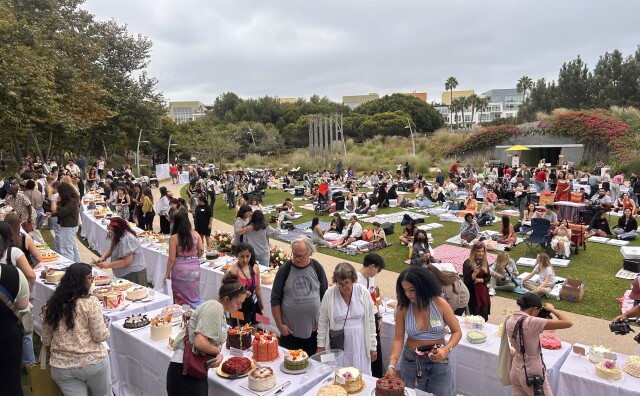Congress has cut federal funding for public media — a $3.4 million loss for LAist. We count on readers like you to protect our nonprofit newsroom. Become a monthly member and sustain local journalism.
This archival content was written, edited, and published prior to LAist's acquisition by its current owner, Southern California Public Radio ("SCPR"). Content, such as language choice and subject matter, in archival articles therefore may not align with SCPR's current editorial standards. To learn more about those standards and why we make this distinction, please click here.
Alarming Suicide Rates At A Women's Prison Spur Calls For Action

Over an 18-month period from 2014 to 2015, there were four suicides and at least 20 attempted suicides at a female-only prison in San Bernardino County. There had been a total of three suicides at the California Institution for Women (CIW) in the 14 years prior. Multiple groups, including the California Coalition for Women Prisoners (CCWP), are demanding that CIW and the California Department of Corrections and Rehabilitation (CDCR) take action to stem the epidemic.
A recent, galvanizing case is that of Erika Rocha, a 35-year-old inmate who hanged herself on April 14. A Guardian article explores how Rocha was tried as an adult for attempted murder at age 14 and sentenced to 19 years to life. She was put in solitary confinement at 16 and held there until she turned 18, and had just come off of suicide watch when she succeeded in killing herself.
Rocha's case lies at the intersection of several issues within the justice system. Her death came at the tail end of a long line of alleged abuses by law enforcement and CIW, starting with claims of a coercive police interrogation and going through, among other things, multiple stints in solitary confinement. Truthout says:
Erika's story highlights how the criminal legal system intimidates, coerces and traps people, especially low-income youth of color. As a Latina youth, it was 43 percent more likely that Erika would be prosecuted as an adult and 40 percent more likely that she would be admitted to an adult prison compared to a white youth. As a poor youth in a foster care group home, Erika faced a much higher chance of incarceration.
Of particular note in the case of Rocha and CIW is the use of solitary confinement (generally a method of punishment) for inmates on suicide watch (a matter of mental health care). “She needed help,” Rocha’s sister Geraldine told The Guardian. “She needed somebody there for her, not to say: ‘Here, go sit in a room by yourself and maybe it will go away.’”
According to CCWP, at least one other suicide has occurred at CIW since Rocha's, and a further 22 women have been put on suicide watch. CIW's suicide rate is currently eight times that of the national rate for female prisoners and five times that of all California prisoners.
CCWP has posted a petition to the governor on Change.org, demanding that CIW be investigated. As of the time of this writing, it has 6,490 signatures—1,010 away from its goal of 7,500.
As Editor-in-Chief of our newsroom, I’m extremely proud of the work our top-notch journalists are doing here at LAist. We’re doing more hard-hitting watchdog journalism than ever before — powerful reporting on the economy, elections, climate and the homelessness crisis that is making a difference in your lives. At the same time, it’s never been more difficult to maintain a paywall-free, independent news source that informs, inspires, and engages everyone.
Simply put, we cannot do this essential work without your help. Federal funding for public media has been clawed back by Congress and that means LAist has lost $3.4 million in federal funding over the next two years. So we’re asking for your help. LAist has been there for you and we’re asking you to be here for us.
We rely on donations from readers like you to stay independent, which keeps our nonprofit newsroom strong and accountable to you.
No matter where you stand on the political spectrum, press freedom is at the core of keeping our nation free and fair. And as the landscape of free press changes, LAist will remain a voice you know and trust, but the amount of reader support we receive will help determine how strong of a newsroom we are going forward to cover the important news from our community.
Please take action today to support your trusted source for local news with a donation that makes sense for your budget.
Thank you for your generous support and believing in independent news.

-
According to a grand jury report the contractor took advantage of strained relations and political pressures to “force” the city to pay hundreds of millions of dollars to settle disputes.
-
Administrators say the bargaining units should be dismissed, or that they have no standing. One campus is going after the federal agency in charge of union activity.
-
The landslide is not connected to the greater Portuguese Bend landslide, city officials said.
-
Nom. Nom. Nom. The event destroyed the internet when it was first announced — and sold out in minutes.
-
The critical findings are part of long-awaited after-action report was released Thursday. It contains recommendations for increasing emergency staffing and updating old systems.
-
Diving has changed, mountain biking has been added. Here's where to watch the Olympics in person in 2028.







